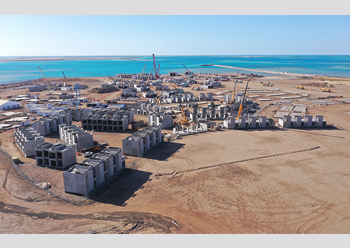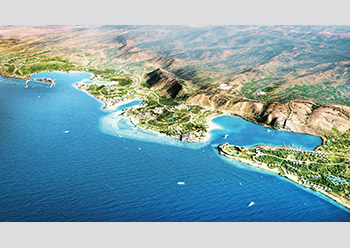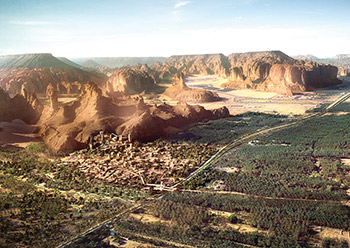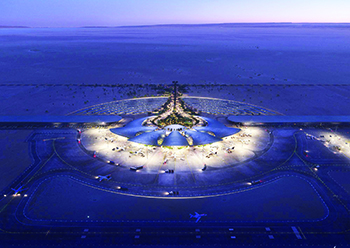
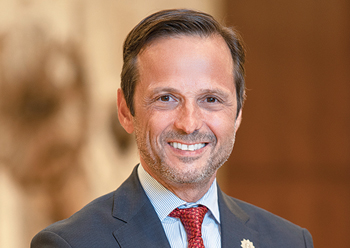 Pagano ... exciting challenge.
Pagano ... exciting challenge.
What are the strategies and technologies being employed at The Red Sea Project to ensure that work is carried out to plan, while ensuring quality and a focus on the environment, especially in view of the Covid-19 crisis?
The safety of our staff and those working on site is always our Number One priority. Fortunately, Covid-19 has not halted our progress and, while following strict government and health guidelines, we have been able to continue developing the destination with Phase One on track to be completed in 2023.
Throughout the pandemic, we have been able to maintain 40 per cent of our workforce on site safely. To ensure that everyone has had enough space to social distance, we moved a proportion of workers to temporary accommodation outside of our Construction Village, including four local schools.
In 2020, we awarded a contract to International SOS-Al Rushaid, to provide all medical services across the development during the initial construction phase of the project and in March, we opened our state-of-the-art central medical facility. This contract was awarded to ensure the highest quality medical care and assistance is provided to the site’s estimated 28,000 construction workers, as well as the project’s staff and visitors over the next two-and-a-half years.
In terms of the environment, at TRSDC, we truly believe in embracing innovation to enhance it. We have a number of strategies and technologies in place to ensure that the work carried out meets our strict and ambitious sustainability goals.
Our Smart Destination team is looking at how technology can be used to protect the environment, such as 3D coral printing and coral farming to boost coral populations. We are embracing nature-based solutions in addition to technical approaches for carbon sequestration, including growing more mangroves and seagrasses, and even mechanical trees, which will help us achieve 100 per cent carbon neutrality.
We plan to deploy around 2,500 Internet of Things (IoT) sensors throughout the coral reefs, turtle nesting sites and the wider lagoon. These will monitor any changes that could be a cause for concern and flag when action needs to be taken, as well as measure our progress against our target of achieving a 30 per cent net conservation benefit by 2040.
Leading The Red Sea Project’s development from the ground up to create a unique and sustainable international tourism destination is a challenge indeed. You have now taken on the mantle of leading Amaala too. How do you manage this huge challenge?
It’s definitely a huge challenge to step up and take on the responsibility of a second giga-project, particularly knowing the key role both projects play in the delivery of Vision 2030. However, it is a challenge that excites me.
My experience as Managing Director, Development of the prestigious Canary Wharf Group in London and President of Baha Mar Development Company, a luxury hospitality and residential development company in the Bahamas – both transformational projects in their own right – has definitely equipped me with the skills needed to rise to the challenges ahead.
Overseeing two large-scale projects is not uncommon with projects that share synergies and ambitions. Each project has a dedicated team of experts focused on delivery and I am lucky to have two strong teams supported by a world-class group of contractors and partners, all of whom have a vast amount of experience working on these types of projects both locally and globally.
What are some of the challenges you have encountered in leading a project of this scale since its inception?
A large proportion of what we are doing at The Red Sea Project has never been done before, not just in Saudi Arabia, but anywhere else in the world. From our approach to regenerative tourism to the fact we’re building our own infrastructure that ensures we are off grid and 100 per cent powered by renewable energy, a lot of what we’re doing is new. This not only challenges us, but also challenges the contractors we work with to come up with novel solutions.
For example, to allow us to become the largest tourism destination in the world run entirely on renewable energy, we are building the world’s largest battery storage facility. Likewise, our strict sustainability commitments mean for any development works we carry out, we must ensure that the habitat and wildlife are protected at all costs. Whilst challenging, this commitment to protecting the environment has resulted in us exploring a number of innovative solutions with key partners, including 3D coral printing and coral farming processes to boost coral populations.
The location and sheer size of the project is also particularly challenging, and we have a variety of landscapes and topographies to consider. From the mountain resort we are building, to the overwater villas, no two parts of the site are the same, which is why the infrastructure must adapt. For instance, in order to create our Desert Rock mountain resort, we’re having to physically build the rooms and hotels into the mountain side around huge rocks and valleys, echoing the style of the Nabateans who came before us.
What is the vision in creating a synergy between The Red Sea Project and the Amaala projects?
The kingdom’s Vision 2030 programme lays out the framework to diversify the economy with three main themes: a vibrant society, a thriving economy and an ambitious nation. Both Amaala and The Red Sea Project are key developments contributing to this long-term diversification programme. We firmly believe that they will positively contribute to the local economy and open the world’s eyes to this beautiful country.
Both The Red Sea Project and Amaala are located on the largely untouched and unexplored pristine Red Sea coast and we see both destinations acting as gateways for the world into the kingdom, showcasing its beautiful, untouched natural landscapes and undiscovered cultural heritage. Both projects are also underpinned by an ambitious commitment to sustainability, both environmentally and socio-economically too.
Yet while there are many similarities that allow synergies to be realised, the destinations are also quite different in essence, in terms of both the topography and landscape, and in the experiences offered.
The Red Sea Project includes inland resorts but is predominantly a destination built around a stunning archipelago of more than 90 islands. On the contrary, Amaala is situated on a stretch of coastline, rich in intriguing bays lined with some of the best corals in the Red Sea – hence our main development is named “Triple Bay”.
Amaala is focused on health and wellness, and arts and culture, for example, while The Red Sea Project is developing immersive regenerative experiences in nature and adventure.
Please comment on the progress achieved to date on The Red Sea Project, given the fact that it is a unique development in a remote location and like all projects, will have faced challenges in the wake of the Covid-19 crisis?
Despite the difficult circumstances surrounding the pandemic, we have continued to make significant progress on the ground and have awarded more than 500 contracts worth over SR15 billion ($4 billion) to local and international partners.
The 100-hectare landscape nursery – the largest in Saudi Arabia, which will provide more than 15 million plants for the destination – has been operational since early 2020. There are more than 7,000 workers currently on-site and the first 80 km of new roads are now complete. The Construction Village, which is set to house 10,000 workers, is already open and development is also progressing well at the Coastal Village, which will be home to around 14,000 people who will eventually operate the destination. This includes a three-star management hotel which will open by the end of Q2, the first accommodation and our new offices, set to open in Q3.
Last year, we marked a significant milestone in the construction of our eco-friendly Red Sea International Airport with the award of a substantial contract to an all-Saudi JV between Nesma & Partners and Almabani, ahead of the airport opening in 2022. The package for airside infrastructure works includes the design and building of a Code F runway 3,700 m long, Code B seaplane runway, parallel and link taxiways and pavement works, aeronautical navigational aids, aerodrome ground lighting, airside utilities, helipads, roads and associated buildings.
Phase One of the project remains on track with the first few hotels due for completion by the end of 2022 along with our dedicated international airport. The remainder of Phase One assets will complete in 2023, to total 16 hotels and 3,000 rooms across five islands and two inland resorts, as well as commercial, retail and leisure facilities and other infrastructure.
We have an exciting year ahead at TRSDC. As we move into a post-Covid world, we are creating more partnerships, breaking new ground and continuing to move forward with our plans to welcome the first guests by the end of 2022.

















.jpg)













 (1).jpg)















































